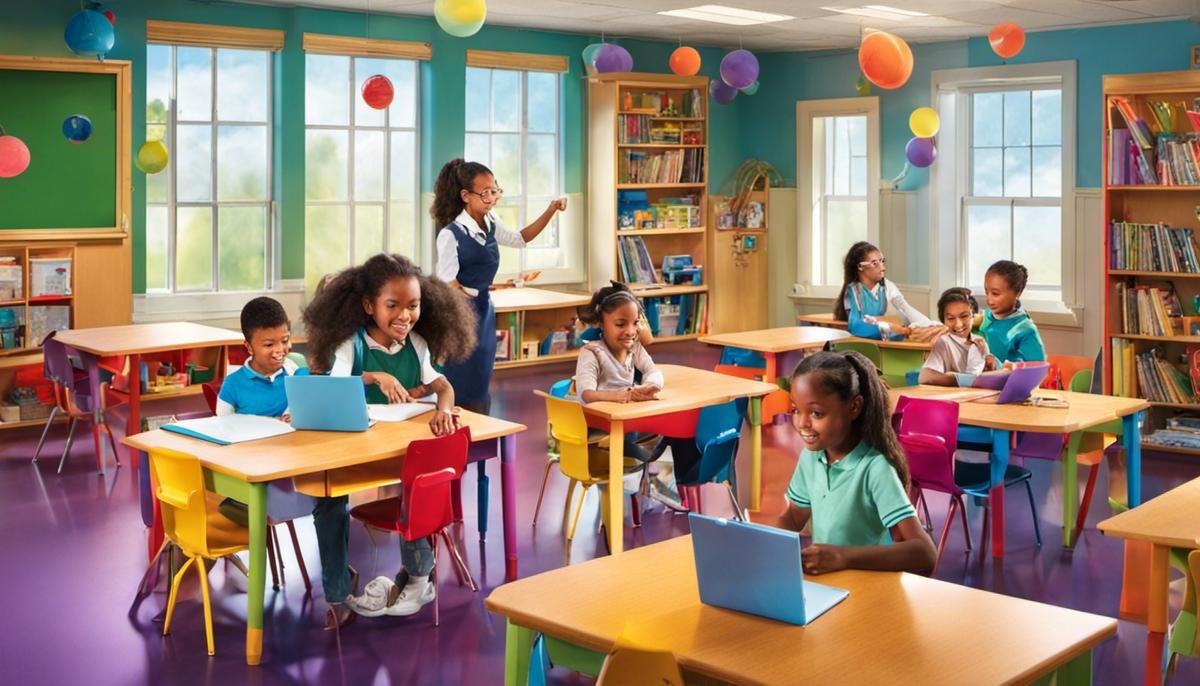
Autism Spectrum Disorder (ASD) is a complex and unique developmental disorder which affects many aspects of a person’s life, particularly learning. As a population exhibiting a wide range of abilities and challenges, autistic students often face unique educational difficulties which can create barriers to their learning journey. These challenges are deeply rooted not only in academic learning, but also in social interactions, communication skills, and cognitive abilities. It is of vital importance to have a comprehensive understanding of these challenges, which could accelerate the formulation of effective teaching strategies and classroom accommodations. This in-depth look at autism education will serve as a guide for educators, parents, and learners, illuminating common challenges and offering practical solutions.
Understanding Autism and its Impact on Learning
Navigating the Learning Pathways of Children with Autism: An Understanding
Ever noticed how a child explores the environment, understands things, and applies that learning to daily life? Each child has a unique learning style, pacing, and interests. However, the journey can be a tad bit different for children on the Autism Spectrum.
Autism Spectrum Disorder (ASD) affects the neurodevelopment of a child and can have a significant impact on their learning abilities. With each child having a unique experience with this spectrum disorder, it’s crucial to adopt a flexible mindset. Let’s unravel this complex path to better support our precious ones.
Children with autism often have distinctive learning abilities. Although it might seem challenging initially, the key is using these unique characteristics to tailor an individualized learning approach.
One of the remarkable aspects of learners with autism is their ability to think visually. They encode information better with pictures or visuals. Remember, a visual schedule can be an excellent tool to make the day predictable for a child with autism. It will not just validate their learning style, but also make them feel secure in their environment.
Another point to take note is their detail-oriented nature. While others might see a tree, a child with autism might see each leaf, branch, and color on it! This approach can be beneficial in areas that require meticulous knowledge. However, it can also hinder the ability to grasp the bigger picture. Hence, consider offering comprehensive overviews before diving into the details.
Despite the challenges, children with autism often excel in rote memory skills. They can remember detailed information for an extended period. Celebrate this unique ability, but focus on teaching practical ways to apply these facts in the real world. Remember, learning extends beyond mere facts and figures.
At times, the individuals on the spectrum might have a particular fixation. These strong interests can guide their learning journey, making it more meaningful and engaging for them. Utilize this passion for your teaching strategies. For example, if they are interested in planes, incorporate it into language learning, math activities, and more.
Let’s not overlook the challenges, though. Children with autism often struggle with social interaction, making it difficult for them to learn from their peers. Role-play and social stories can be of great help in such instances.
While sensory overload is a common challenge for these children, remember, each child’s sensory experience is unique. Familiarize yourself with the sensory preferences of the child to maximize their learning experiences.
Navigating the learning pathway of a child with autism might seem like an uphill task at times, but have faith. With patience, understanding, and a touch of creativity, every hurdle can be transformed into a stepping stone. Every child has a unique way of interpreting the world – our journey is to help them do it in the most joyful and enriching way possible.

Common Educational Challenges for Autistic Students
Navigating the Educational Landscape: Unraveling the Challenges Faced by Autistic Students
For numerous parents and educators, understanding the educational needs of autism-affected youngsters can feel like deciphering a complex puzzle. Each piece, each challenge, modifies the overall image and trajectory of their learning. Exploring some of these hurdles can be the initial step towards devising effective strategies that not only address these challenges but embrace the unique strengths and talents of these spirited learners.
One of the main challenges experienced by universal education systems is adopting the one-size-fits-all paradigm which inherently fails to cater to the multifaceted learning styles of autistic students. Pedagogical methodologies that hinge on verbal instructions and abstract concepts, for instance, can become intimidating roadblocks. Instead, methods that capitalize on their visual and kinetic learning capabilities are often more effective.
Language comprehension difficulties constitute another considerable challenge for these sharp minds. Subtle nuances of everyday communication or idiomatic expressions may elude their understanding, potentially resulting in confusion and stress. Therefore, clear, precise language without metaphors or ambiguous references can go a long way in making lessons more accessible.
The abstract nature of certain subjects, such as mathematics, may become grueling for autistic students who often thrive on routines and predictable patterns. The switch from concrete arithmetic operations in the early years to more abstract mathematical concepts can be daunting for them. This calls for a meticulously planned transition, broken down into incremental steps that correlate practical examples with abstract notions.
Another facet that necessitates attention is the unfamiliarity and discomfort exhibited by these students towards new surroundings. While this may seem trivial, it can become a serious impediment to learning. Introducing alterations in a gradual manner, providing ample time to adjust, and maintaining a consistent routine can aid in mitigating the anxiety associated with such changes.
While autism can introduce unique challenges, it’s worth noting that this should not eclipse the incredible potential these students possess. By understanding their needs and tailoring educational approaches to meet them, we can ensure an inclusive learning environment that recognizes and cherishes their unique abilities. It’s about seeing the world through their lens, appreciating their distinct perspective, and most significantly, empowering them to navigate their educational journey with confidence and success.

Teaching Strategies & Classroom Accommodations
Welcoming Change: Helping Our Autistic Students Flourish
There’s no doubt that every child is unique, with their unique learning style. For our children who find the world more vibrant and extraordinary – our autistic children – this uniqueness may demand more attention, understanding, and flexibility in the classroom.
Creating Effective Teaching Strategies for Autistic Students
In the realm of education, a “one-size-fits-all” approach is often the norm, falling short of accommodating our autistic children’s distinct learning styles. This approach can lead to unnecessary stress and confusion for our little learners. Instead, adopting teaching strategies that cater to their individual needs creates an environment that promotes learning and growth.
Harnessing Visual and Kinetic Learning Methods
Visual and kinetic instructional activities are highly effective learning tools for autistic students, providing them with concrete representations to understand abstract concepts. Hands-on, interactive activities and using visual aids such as diagrams, charts, or pictures can significantly enhance their learning experience.
Emphasizing Clear and Precise Language
Children with autism may struggle with understanding language, especially when filled with ambiguous phrases or idioms. Teachers can improve communication by using clear, simple language, literal explanations, and breaking down instructions into smaller, manageable parts.
Easing Abstract Subjects
Mathematics can be a daunting subject for our autistic students due to its abstract nature. Transitioning to abstract concepts should be gradual, employing the use of concrete examples or visual aids for better understanding.
Fostering Comfort with New Surroundings
Unfamiliar environments can trigger discomfort or anxiety for our autistic children. Therefore, maintaining consistency is crucial. Creating a routine they can rely on will boost their confidence. Gradual changes instead of abrupt ones will also help them adapt better to new learning scenarios.
Classroom Accommodations: Recognizing Their Unique Potential
There’s so much potential hidden within our autistic students. The key lies in recognizing it and cultivating an environment that allows it to bloom. Small yet significant steps can make a huge difference in harnessing this potential.
The education system needs to make room for embracing the strengths of our autistic students. This includes appreciating their uncanny attention to detail, their impressive memory skills, or the way they see the world from a unique perspective. The journey may be a challenge, but with patience, understanding, creativity, and adaptive teaching strategies, we can help our autistic students navigate this pathway and flourish in their own unique ways.
In the end, it’s about creating an inclusive, understanding, and supportive learning environment in our homes, schools, and communities. And remember, every effort made is a stride towards creating a better world for our children. They are extraordinary and it’s time we help them realize their full potential. Because, isn’t that what we all yearn for – to see our children succeed and develop to their best selves amidst love, acceptance, and understanding?

Importance of Collaboration between Parents and Teachers
The true beauty of education lies in its power to be flexible and adaptable, meeting the individual needs of every student. From our experience in the realm of educating autistic students, a significant part of this process involves a partnership between parents and teachers. This collaboration can be especially potent when it focuses on the unique strengths and challenges of the autistic student. Here’s a closer look into how this team effort can pay off in dividends in the quality of an autistic student’s education.
Active engagement and communication between parents and teachers can help create productive learning environments. Parents can share insights about the unique behavioural cues of their children, their motivation triggers, and their individual coping strategies. This information is priceless, as it aids teachers in providing instructions and setting up the classroom to suit the child’s specific needs.
Continuity is deemed essential in maintaining a sense of peace in students with autism. Ensuring the teaching approaches at school and the support strategies at home are consistent helps in maintaining this continuity. For example, if a particular learning tool or technique is effective at home, sharing it with the teacher can enable them to incorporate it into their teaching, strengthening the learning experience substantially.
Moreover, evidence suggests that with autism, breaking down learning into smaller, manageable tasks can be effective. Parents and teachers working together to identify these smaller tasks can make the learning process smoother. They can also collectively use each child’s unique interests as springboards for lessons to grab students’ attention and make learning more engaging.
Integrating parent-teacher collaboration into Individual Education Plans (IEP) can be incredibly helpful. Parents bring in a wealth of functional and behavioural expertise regarding their child, contributing significantly to the creation and modification of the IEP. Teachers can then use this to create targeted instruction and an ideal classroom environment. Such collaboration can significantly boost the efficacy of the IEP in meeting the needs of the student with autism.
Finally, fostering open lines of communication enhances quick intervention when challenges arise. Timely alerts from either side about behavioural changes, emerging interests, or difficulties can lead to prompt action and resolution. This joint approach to problem-solving can essentially provide vital support to the educational journey of an autistic student.
Parents and teachers, remember, you are on the same team. And the goal is to create an enriching learning experience adapted to the unique needs of children with autism. It’s might not be a walk in the park, but the rewards are worth every effort. Patience, understanding, and collaboration can indeed pave their paths to success. It’s not just about conventional school tasks, but also about equipping them with the cognitive, social, and life skills that are critical for navigating through life. Together, it is possible, and together, every autistic child can be left smiling, successful, and empowered.

Encouraging Independence and Self-Advocacy in Autistic Students
Creating Independence Among Autistic Students – The Power of Empowerment
One of the most crucial aspects of working with autistic students is helping them cultivate a sense of self-advocacy and independence. This idea is not merely about teaching autistic students to exist separately from others, but rather, it’s about empowering them with the confidence and skills to express their needs, desires, and rights effectively.
Indeed, instilling the notion of empowerment into daily learning can begin with something as simple as choice-making. Simple options, such as picking out their clothes, selecting a snack, or choosing an activity, can be ground-breaking in cultivating decision-making skills in autistic students. Along the way, it’s important to verify their choice, reinforcing that their decisions are valued and respected. This creates a safe environment where their voices are heard, therefore fostering a sense of autonomy and the confidence to make significant decisions in the future.
In parallel, it’s equally important to encourage autistic students to communicate their needs and feelings adequately. This involves equipping them with the right communication tools tailored to their unique abilities. Whether these tools are verbal phrases, body language, sign language, communication boards, or alternative augmentative communication (AAC) systems – it’s critical to respect and acknowledge their communication style.
While fostering communication, we must also not overlook the role of practicing self-care tasks to build independence. By taking the time to teach these students daily practical life skills – from personal hygiene to cooking and organizational tasks, we teach them the practicalities of roads to independence.
Another empowering strategy is through problem-solving. Autistic students may often struggle with problem-solving skills due to difficulties in abstract thinking. By illustrating clear step-by-step methods and using visual aids, we can show these students how to break down complex problems into manageable pieces. This approach not only simplifies the problem-solving process but allows autistic students to understand that every problem does not necessarily demand a perfect solution. Their aim should be to find a reliable solution that works for them, further cultivating their ability to navigate life’s challenges.
Last but not least, let’s not forget the influence of positive reinforcement. Praising autistic students, not just for triumphs but for their efforts as well, can go a long way towards encouraging self-advocacy. It aids in building their self-esteem and reinforces the idea that they are capable individuals. Positive reinforcement enhances the motivation to overcome obstacles, fostering resilience and tenacity.
It’s worth considering that self-advocacy and independence will look different for every student with autism. It’s a journey that evolves as they grow and mature. As educators, parents, and care providers, providing constant support, using effective tools, and modeling encouraging behaviors can have a significant impact on an autistic student’s journey toward self-advocacy and independence. It’s about filling their toolbox with the proper adjustments that will empower them in the long run.
Never underestimate the power of believing in an autistic student’s abilities. With patience, understanding, and the right balance of support and independence, we can empower these extraordinary children to reach their fullest potential.

Empowering autistic students to become self-advocates is one of the most valuable tools we can equip them with for navigating their life journey. Encouraging independence, making room for their unique perspectives, and teaching them to express their needs effectively, boost their self-confidence and promotes a greater understanding of their rights. Such empowerment cannot be achieved single-handedly; it is built on the foundational collaboration between parents, educators, and the student. This spirit of cooperation and the tireless pursuit of inclusive and effective educational strategies paves the way for autistic students to thrive, granting them access to the best possible learning experiences and helping to secure their future success.




